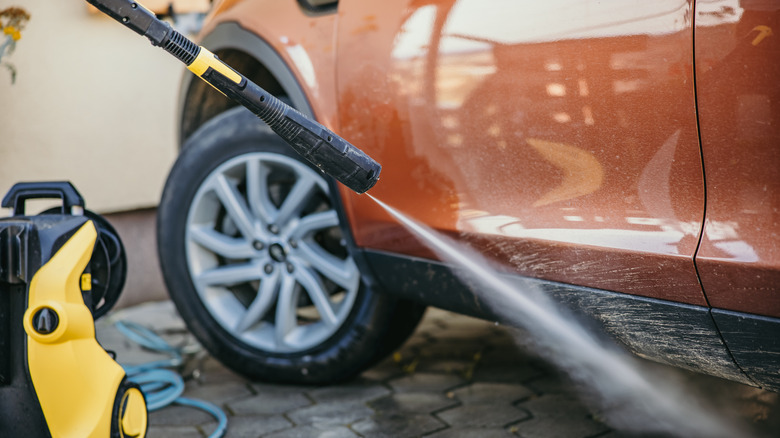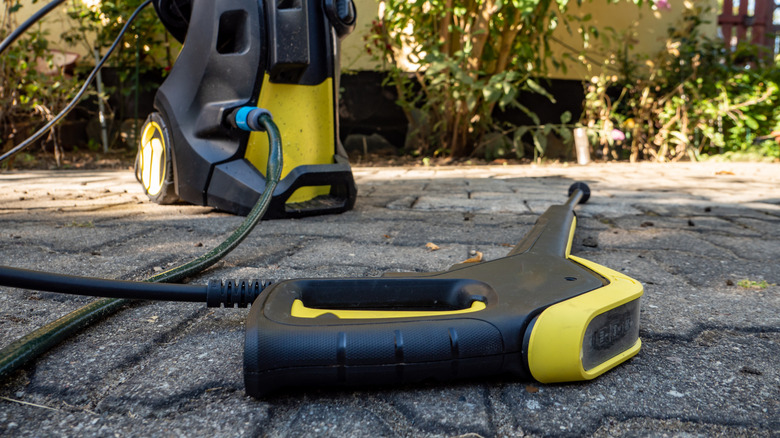
No matter how safe you think your car is from stains, washing it is an inevitability. The fact is that the more you drive your vehicle, the more likely it is to encounter dirt, debris, and other natural elements during its travels. Depending on where you live or how often you drive your car, the kinds of messes your vehicle is exposed to regularly can get pretty severe and call for a heavy-duty solution. While a good pressure washer may seem like the natural answer for such a problem, it's just as easy
to see why someone would be hesitant to use such a tool.
The same power that makes pressure washers effective in an array of outdoor home applications might come across as excessive for use on a car, as there may be genuine concern that it could create scratches, strip paint, or even damage components. To prevent such undesirable results from occurring while ensuring you get a thorough clean, it's important to pay close attention to the pounds per square inch, or PSI, exerted by your pressure washer. This metric determines the force being exerted by the spray, with higher numbers indicating that the pressure washer will deliver a harsher stream.
As a general rule of thumb, it's best not to go over 1500 PSI when washing your car with a pressure washer. It can be tempting to exceed such recommendations, as even many pressure washers recommended for cars can easily push past this number. But in truth, PSI isn't the only factor to consider when effectively tackling your car with the pressure washer.
Read more: 7 Harbor Freight Icon Tools That Are Worth Buying (And 3 To Avoid)
GPM May Be More Important Than PSI

The PSI settings of your pressure washer can leave a notable impact on how your car turns out after a wash, but it's not the only aspect that can affect how things turn out. One lesser thought of element relating to pressure washer performance is the gallons per minute, or GPM. As its name suggests, this is a measurement of the pressure washer's water flow, or volume of water being used.
The GPM rating is a crucial aspect to take note of, as it reveals how much water is being released every minute, in turn determining the overall efficiency of the cleaning job. The higher this rating, the greater the water flow, meaning it will take less time to clean larger areas of debris. Pressure washers with higher GPM ratings are often sought out by professionals for just this reason. While this typically means these machines are more expensive on average, they can be a worthwhile investment for most people, providing a sufficient cleanse while being less destructive than a pressure washer with an overly high PSI rating. Of course, that doesn't mean that a higher PSI setting isn't necessary in some occasions. For those with especially tough stains and grime caking their vehicle such as sap or graffiti, a stronger force may be what's needed to solve the issue.
Other Things To Consider When Using A Pressure Washer On Your Car

No matter the brand, proper pressure washer use goes far beyond what your tool is rated for. Although these specs are important to take note of, equally as crucial are the accessories used and the way in which you position your pressure washer while using it. This is especially important when washing a car as a way of preventing damage or a less-than-satisfying cleanse.
The nozzle type can have a surprising effect on how your pressure washer performs. In general, you'll find that a smaller nozzle size will produce a strong jet of water, intensifying the pressure. While different situations may call for you to swap out the nozzle for a different size, a 25-degree or larger nozzle size is the best to use on a car. Any size smaller can cause damage to the surface.
Likewise, take caution with how close you are while doing a wash. As you can imagine, the closer you are to the car, the more intense the wash can get. So be sure you're maintaining a healthy distance, getting the nozzle no closer than six inches away from the vehicle at any time. Avoid touching any portions of your car that are already peeled or damaged with the pressure washer entirely. Instead, wash these sections by hand with a microfiber cloth to lessen the chances of further impairment.
Want the latest in tech and auto trends? Subscribe to our free newsletter for the latest headlines, expert guides, and how-to tips, one email at a time.
Read the original article on SlashGear.










